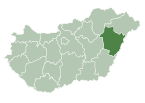Görbeháza
Görbeháza | |
|---|---|
 | |
| Country | |
| County | Hajdú-Bihar |
| Area | |
• Total | 80.2 km2 (31.0 sq mi) |
| Population (2015) | |
• Total | 2,366[1] |
| • Density | 29.5/km2 (76/sq mi) |
| Time zone | UTC+1 (CET) |
| • Summer (DST) | UTC+2 (CEST) |
| Postal code | 4075 |
| Area code | 52 |

Görbeháza is a village in Hajdú-Bihar county, in the Northern Great Plain region of eastern Hungary.
Location
[edit]It is located in the north-western part of the county, about 50 kilometres north-west of Debrecen, and a similar distance from Miskolc and Nyíregyháza.
A separate part of the municipality is Bagota, 9 km south of the centre.
The immediate neighbours are Hajdúnánás to the north-east, Hajdúböszörmény to the south-east, Balmazújváros to the south, Újszentmargita to the south-west, Folyás to the west and Polgár to the north-west.
History
[edit]The original name of Görbeháza was Görbeházpuszta, which belonged to the neighbouring settlement of Polgár. It was named after the L-shaped house there, which is called "görbeház" in this region. According to tradition, this house was a tavern on the edge of the Hortobágy puszta, frequented by shepherds and outlaws, with a large cellar, traces of which can still be seen today.
The history of the village was intertwined with the neighbouring settlement of Polgár, which was a part of the civil estate of the Eger Chapter.
According to the 1910 census, Görbeház is a bare inhabited place with 165 inhabitants. During the Nagyatád land reform, the idea of creating a settled village in Polgár was raised. The idea was motivated by the fact that the present area of Görbeháza, the estates called Nagykapros and Lipcsei-hát, which were intended for distribution anyway, were far away from Polgár (13 km) and were considered to be very unsuitable for cultivation in small pieces.
Under the land reform, a new settlement village was created in Görbeház-Puszta in 1924.
The village was actually built between 1925 and 1929, in a planned engineering layout, for which the builders received state loans.
Its population grew rapidly as new plots were allocated in 1939-1940 as a result of national land policy measures. At that time, its independence was no longer in doubt, but it was not formally granted until 1945, when it had a population of 1,638 inhabitants and was granted the status of a large municipality in that year.
The name of the municipality, which had previously been provisionally called Görbeháza, was finalised by Decree No 015.304 (12.III.1948) of the Minister of the Interior. [2]
Geography
[edit]It covers an area of 80.2 km2 (31 sq mi) and has a population of 2366 people (2015).[1]
References
[edit]- ^ a b Gazetteer of Hungary, 1 January 2015. Hungarian Central Statistical Office. 3 September 2015
- ^ "Magyar Közlöny igazolasok" (PDF). The Hungarian Royal Gendarmerie. Archived (PDF) from the original on 22 October 2022.
47°50′N 21°14′E / 47.833°N 21.233°E


